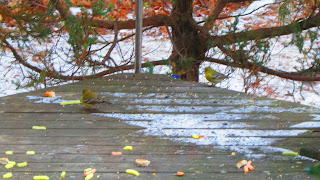NATURE MONCTON INFORMATION LINE, Dec.22,
2020 (Tuesday)
Please advise editor at nelsonpoirier435@gmail.com if any errors are noted in wording or
photo labeling.
For more information on Nature Moncton, check into the website at www.naturemoncton.com
Edited by: Nelson Poirier nelsonpoirier435@gmail.com
Transcript by: Susan Richards susan_richards@rogers.com
Info Line # 506-384-6397 (384-NEWS)
To respond by e-mail, please address your
message to the information line editor nelsonpoirier435@gmail.com
**Ray Gauvin noted a BLUE JAY [Geai bleu] coming to his Shediac feeder
yard with an apparently drooping injured wing (photo). Ray expects it will recover naturally as it
seems quite able to feed and lift off in flight.
Note the blue eye in one of the MOURNING DOVE [Tourterelle
triste] photos. This is very likely the
nictitating membrane (third eyelid) birds use to protect the eye when necessary.
Also, Ray has a surprising quartet bonus of 4
PINE
WARBLER [Paruline des pins] coming to his Shediac feeder yard.
They enjoy bread crumbs, nyjer seed, and sunflower seed spread on the
deck and suet at feeders. Most of us are lucky to have one as a winter patron
at feeder yards!
Ray also sends a photo of a
male and female DOWNY WOODPECKER [Pic mineur].
Note the narrow dark bands on the white tail
side rectice on the Downy Woodpecker that the Hairy
Woodpecker [Woodpecker poilu] does not have. Sometimes they
don’t show this unless the tail is spread a bit.
**Annegret Lamure got a photo
of a BALD
EAGLE [Pygargue à tête blanche] pair perched in a heart-shape drying off after unsuccessfully divebombing
ducks on the narrowing Petitcodiac River.
Note the smaller bird on the right which would be the male with the
larger female on the left.
**Eric Wilson shares a link to
a commentary that Bees are now considered the most important thing on
earth. Take a look at the link below.
https://blog.therainforestsite.greatergood.com/why-are-bees-important/?fbclid=IwAR39
**Brian Stone travelled the
coast from Pointe-du-Chene to St.Thomas wharf on Monday scanning for
interesting bird life. LONG-TAILED DUCK [Harelde
kakawi] are still present at the Pointe-du-Chene wharf plus a distant HARBOUR SEAL [Phoque
commun]. At the big Lobster aside the Foch
Bridge, there were MALLARD [Canard colvert] and Black Ducks [CANARD NOIR] and a few COMMON MERGANSER [Grand Harle] plus a flock of approximately
30 COMMON
REDPOLL [Sizerin flammé]. At Caissie Cape wharf he noticed
fog starting to set in and there were some Long-tail Ducks there also plus
distant BLACK SCOTER [Macreuse noire] (some at all stops actually). At
the Cormierville wharf the fog was too thick to see anything and it was the
same at the St.Thomas wharf.
**Things are turning
around. The Winter Solstice happened on
Monday with our shortest day and longest night of the year but, now it is
Tuesday December 22nd and we will have a slightly longer day of
light. It may be still in seconds, but
those seconds will soon turn into minutes which will be signalling many members
of the wildlife community to start thinking about family planning so young will
be born when resources are most abundant.
nelsonpoirier435@gmail.com
Nelson Poirier,
Nature Moncton













